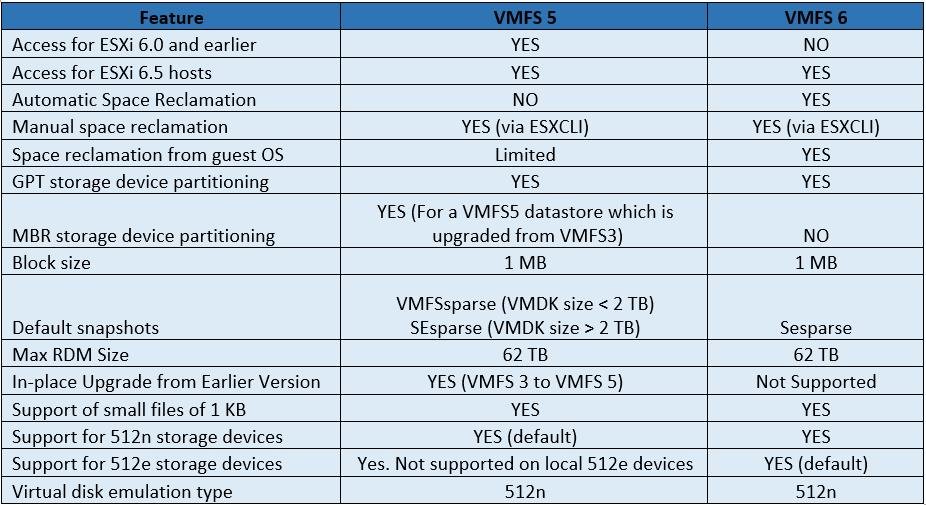VMFS 6 (Virtual Machine File system 6) is released with vSphere 6.5. VMFS 6 released with vSphere 6.5 contains a lot of new features as compared to earlier version of VMFS (VMFS 5). I will help you to understand the difference between VMFS 5 & VMFS 6 in this article.
VMware vSphere 6.5 is released with lots of cool features and configuration maximum as compared to the earlier versions of vSphere. Take a look at the article to understand the difference between VMWare vSphere 6.0 & vSphere 6.5. With VMWare vSphere 6.5, more focus turned towards the vCenter Server appliance as compared to the windows version of vCenter Server. Take a look how to migrate windows vCenter server to vCenter Server appliance 6.5.
Some of the new features of vSphere 6.5 are like vCenter native HA (only on the vCenter appliance), In-build update manager with VCSA and native VCSA backup & restore are one of the reasons for you to upgrade your vSphere to latest vSphere 6.5. if you consider additional reason to upgrade your vSphere to vSphere 6.5, I would say VMFS 6. VMFS-6 is only available in vSphere 6.5 and later.
You still can create VMFS 5 & VMFS 6 with ESXi 6.5. After you upgrade your ESXi hosts to version 6.5, you can continue using any existing VMFS5 datastores. To take advantage of VMFS6 features, create a VMFS6 datastore and migrate virtual machines from the VMFS5 datastore to VMFS6 datastore. You cannot upgrade the VMFS5 datastore to VMFS6.
Below are the some of the new features of VMFS 6:
- Automatic Space Reclamation (which allows storage arrays to reclaim deleted or unmapped disk blocks from a VMFS datastore so it can be used elsewhere)
- Support for 4K Native Drives in 512e mode
- Default SE Sparse (VMFS 5 uses SE Sparse only when VMDK size is greater than 2 TB, If VMDK< 2 TB, VMFS 5 uses VMFSsparse)
Tabular format of comparison between 2 versions will always help us to understand the difference between VMFS 5 & VMFS 6. This is one of the famous article styles of VMware Arena.
Difference between VMFS 5 & VMFS 6
Let’s understand the difference between VMFS 5 & VMFS 6 in the simple tabular format.
I hope you understand most of the difference between VMFS 5 & VMFS 6. I would like to add some information about 512n & 512e storage devices for better understanding. Take look at the DELL article to understand more about advanced disk formats
A sector is a subdivision of a track on a storage disk or device. Each sector stores a fixed amount of data. Traditional 512n storage devices have been using a native 512-bytes sector size. In addition, due to the increasing demand for larger capacities, the storage industry has introduced advanced formats, such as 512-byte emulation, or 512e. 512e is the advanced format in which the physical sector size is 4,096 bytes, but the logical sector size emulates 512-bytes sector size. Storage devices that use the 512e format can support legacy applications and guest operating systems.
When you set up a datastore on a 512e storage device, VMFS6 is selected by default. For 512n storage devices, the default option is VMFS5, but you can select VMFS6.
I hope this article is informative for you. Thanks for Reading!!!. Be social and share it with social media using social share plugins, if you feel worth sharing it.
Some of the Popular Comparision articles of VMWareArena
Difference between VMware vSphere 6.0 & vSphere 6.5
Difference between vSphere 5.0, 5.1, 5.5 and vSphere 6.0
Difference Between vSphere 5.1 and vSphere 5.5
Difference between VMware ESX and ESXi
Difference between Standard Switch and Distributed switch
Difference between ESX 3.5 and ESX 4.0
Difference between vSphere 4.1 and vSphere 5
Difference Between vCenter Server Appliance 5.5 and vCenter Server 5.5 on Windows
Difference Between VMFS 3 and VMFS 5
Difference between Upgraded VMFS 5 and Newly created VMFS 5
Difference Between Clone And Template


